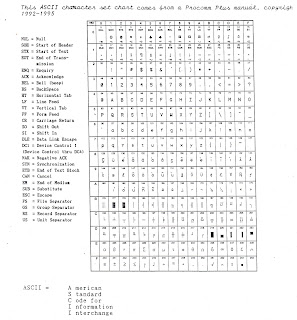Surprise! That has been around ever since Wordstar was used for machine language programming of PCs back when Windows was actually MSDOS 2.0. Somebody has painstakingly made a list of ALL decimal equivalents of ASCII code--me, I have an old chart that reflects all the low-ASCII machine control codes, which are no longer valid today and will produce other interesting results.
Watch this space for other old code standards as I dig 'em up from the ole time machine.
The following is a more graphic representation of the low end of the ASCII code's machine control codes, as they would have appeared using MSDOS. Has only extended ASCII and low ASCII, minus the QWERTY keyboard codes:
Of course it would be a whole lot easier to just post a LINK to a page with a legible chart, but the sense antiquity would have been lost.
I now draw your attention to the part of either chart which shows the decimal code for the ESC. This rendering has been important in producing ANSI art because in order for ANSI code to be flagged as ANSI rather than ASCII, the escape code is required preceding it, in combination with the left bracket.
When using a plain text editor, the ESC code would look like this: `[
So a standard ANSI command would look something like this: `[3;33;44m
Translating that into English, this produces text that is in italic, yellow letters on a blue background; the m indicates display mode. ANSI provides cursor controls, so part of the animation of ANSI involves cursor repositioning and screen rewriting. And blinking. `[2J would clear the screen; `[K clears a single line. `[s saves a cursor position, and after displaying a string of ANSI code, you can return to the saved position by executing `[u.
More about the codes using ANSI.SYS here.
============================================================
May 21, 2014 UPDATE: another one's going around on Facebook today, but it contains a number of errors...
Don't you believe that leading zeros are necessary. The other 4 digit numbers aren't quite correct, either--for example, the upper case sigma (on this image, it's called "Nary summation") is simply Alt-228. It's true that the characters repeat with 4 digit entries, but 4 digit entries aren't necessary.
Before the USB port there was the RS232 serial port for communicating with local devices (on very old machines, it was used for connecting to printers, too, but was too slow. Later machines used the Centronics standard parallel for printers). Got a bunch of old machines you'd like to network without using the Internet or other type ethernet? Use the RS232 port. It's easy--if you can keep 'em straight as to which is used for what side:





1 comment:
1. If it has smiling faces and other graphic characters in the control range (decimal 0-31), it's not ASCII. Putting graphic characters in that range seriously violates the spirit and the letter of ASCII, and therefore of Unicode.
2. If it has anything with a code of decimal 128 or greater, it's not ASCII.
Post a Comment